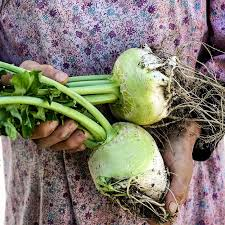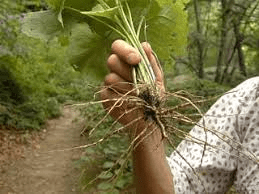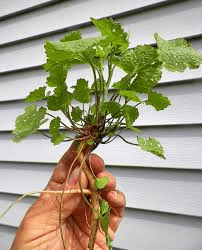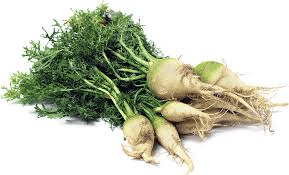Mustard roots are a fundamental part of the mustard plant’s anatomy, essential for the plant’s growth, stability, and nutrient uptake. These roots emerge from the seedling after germination and play several crucial roles throughout the plant’s lifecycle.
The root system of a mustard plant consists of a primary taproot and several lateral roots. The primary taproot grows downward into the soil and is responsible for anchoring the plant securely. This deep root helps stabilize the plant, making it less likely to be uprooted by wind or other environmental factors. It also facilitates access to deeper soil layers where moisture and nutrients may be more abundant, particularly in drier conditions.
Lateral roots branch off from the taproot and spread horizontally through the soil. These lateral roots increase the surface area for nutrient and water absorption. They are crucial for providing the plant with essential minerals and water required for growth. The network of lateral roots also improves the plant’s stability by creating a broader base in the soil.
In mustard plants, the root system is relatively shallow compared to some other crops, which means that mustard plants are well-adapted to growing in looser, well-drained soils. However, the depth and spread of the root system can still vary depending on soil conditions and plant variety. For instance, in nutrient-rich soils, the root system may be more extensive and vigorous, while in poorer soils, the roots might be more confined and less robust.
Mustard roots also contribute to soil health. As they grow and decompose, they add organic matter to the soil, which improves soil structure and fertility. This organic matter enhances the soil’s ability to retain moisture and provides nutrients for other plants. In this way, mustard roots can play a role in sustainable agricultural practices by improving soil quality for future crops.
Moreover, mustard roots have been studied for their role in phytoremediation, a process where plants are used to remove or neutralize contaminants in the soil. Mustard plants, including their roots, can absorb and accumulate heavy metals and other pollutants, helping to clean up contaminated soils. This property makes them valuable in environmental management and remediation efforts.
Mustard roots are crucial for the plant’s stability, nutrient uptake, and overall health. The primary taproot anchors the plant and accesses deeper soil resources, while the lateral roots expand the plant’s reach for nutrients and water. Additionally, mustard roots contribute to soil health and have applications in environmental management. Understanding the role and function of mustard roots provides insight into plant growth and highlights their importance in agriculture and environmental sustainability.
The Economic Importance and Uses of Mustard Roots

1. Soil Health Improvement: Mustard roots enhance soil health by promoting soil aeration and reducing soil compaction. Example: Mustard plants used in cover cropping to improve soil structure.
2. Erosion Control: Mustard roots help prevent soil erosion by stabilizing the soil with their root systems. Example: Mustard cover crops planted on slopes to reduce erosion.
3. Organic Fertilizer Production: Mustard roots, when composted, can be used to produce organic fertilizers. Example: Compost made from mustard plant residues, including roots.
4. Pest Management: Mustard roots can be used in natural pest management systems, such as biofumigation, to control soil-borne pests and diseases. Example: Mustard roots used in biofumigation to suppress nematodes.
5. Green Manure: Mustard roots are used as green manure to enrich soil with organic matter and nutrients. Example: Mustard green manure applied to improve soil fertility.
6. Medicinal Uses: Mustard roots have been used in traditional medicine for their potential therapeutic properties. Example: Herbal remedies using mustard root extracts.
7. Bioremediation: Mustard roots can be used in bioremediation to remove contaminants from the soil. Example: Phytoremediation projects using mustard roots to clean polluted soils.
8. Nutrient Cycling: Mustard roots contribute to nutrient cycling by breaking down organic matter and releasing nutrients back into the soil. Example: Nutrient cycling enhanced by mustard root decomposition.
9. Animal Feed: Mustard roots can be used in animal feed due to their nutritional content. Example: Animal feed incorporating mustard root powder.
10. Crafting Materials: Dried mustard roots can be used in crafting and decorative projects. Example: Craft materials made from dried mustard roots.
11. Soil Amendment: Mustard roots, when added to soil, act as a natural amendment to improve soil texture and fertility. Example: Soil improvement with mustard root incorporation.
12. Cover Cropping: Mustard roots are used in cover cropping systems to protect and enhance soil health. Example: Mustard plants grown as cover crops during the off-season.
13. Bioenergy Production: Mustard roots can be used to produce bioenergy through processes such as biomass conversion. Example: Biofuel production from mustard root biomass.
14. Research Applications: Mustard roots are used in research to study plant physiology, soil interactions, and root development. Example: Research on mustard root growth patterns.
15. Greenhouse Gas Reduction: Mustard roots can help reduce greenhouse gas emissions by improving soil carbon sequestration. Example: Carbon sequestration enhanced by mustard root biomass.
16. Soil Structure Improvement: The root systems of mustard plants help improve soil structure by creating channels and spaces in the soil. Example: Soil aeration and structure improved by mustard roots.
17. Water Management: Mustard roots assist in water management by improving soil water retention and reducing runoff. Example: Enhanced water retention in soil due to mustard root growth.
18. Educational Purposes: Mustard roots serve as educational tools for teaching about plant biology, soil health, and sustainable farming practices. Example: Classroom demonstrations using mustard root samples.
Read Also: Factors that Determine the Amount of Wind Erosion
The Products and By-products That Can Be Derived From Mustard Roots

1. Organic Fertilizers: Mustard roots, when composted, are used to produce organic fertilizers that enhance soil fertility. Example: Organic compost made from mustard plant roots.
2. Bioremediation Agents: Mustard roots are used in bioremediation projects to clean contaminated soils. Example: Phytoremediation with mustard roots to remove soil pollutants.
3. Animal Feed: Powdered mustard roots can be used as a nutritional supplement in animal feed. Example: Animal feed with mustard root powder.
4. Craft Materials: Dried mustard roots are used in crafting and decorative applications. Example: Decorative items made from dried mustard roots.
5. Green Manure: Mustard roots can be used as green manure to enrich soil with organic matter. Example: Mustard green manure for soil improvement.
6. Bioenergy: Mustard roots are used to produce bioenergy through processes like biomass conversion. Example: Biofuels derived from mustard root biomass.
7. Soil Amendments: Mustard roots can be added to soil as natural amendments to improve soil texture and fertility. Example: Soil amendments made from mustard roots.
8. Herbal Remedies: Mustard roots are used in traditional medicine for their potential health benefits. Example: Herbal preparations using mustard root extracts.
9. Cover Cropping Benefits: Mustard roots are utilized in cover cropping systems to protect and enhance soil health. Example: Soil health improvement through mustard cover crops.
10. Research Samples: Mustard roots are used in research to study plant physiology and soil interactions. Example: Research on root development using mustard root samples.
11. Erosion Control Materials: Mustard roots are used in erosion control measures to stabilize soil and prevent erosion. Example: Erosion control with mustard cover crops.
12. Soil Structure Enhancers: Mustard roots improve soil structure by creating channels and spaces in the soil. Example: Enhanced soil structure due to mustard root growth.
13. Water Management Tools: Mustard roots assist in water management by improving soil water retention. Example: Improved soil water retention with mustard root systems.
14. Sustainable Agriculture Practices: Mustard roots support sustainable agriculture by contributing to soil health and fertility. Example: Sustainable farming practices using mustard roots.
15. Greenhouse Gas Reduction Tools: Mustard roots help reduce greenhouse gas emissions through soil carbon sequestration. Example: Carbon sequestration benefits from mustard root biomass.
16. Organic Mulch: Mustard roots can be used as organic mulch to retain soil moisture and suppress weeds. Example: Mulch made from mustard root residues.
17. Educational Resources: Mustard roots are used as educational tools for teaching about plant biology and soil health. Example: Classroom resources using mustard root samples.
18. Pest Management Products: Mustard roots can be used in natural pest management solutions. Example: Pest control products utilizing mustard root properties.
Read Also: 24 Medicinal Health Benefits Of Chaetopappa ericoides (White aster)
Frequently Asked Questions (FAQ’s) About Mustard Roots

1. What are mustard roots?
Mustard roots are the underground parts of the mustard plant that anchor it in the soil and absorb nutrients and water.
2. How do mustard roots improve soil health?
Mustard roots improve soil health by enhancing soil structure, reducing compaction, and promoting nutrient cycling.
3. Can mustard roots be used in composting?
Yes, mustard roots can be composted to produce organic fertilizers that enrich soil.
4. How do mustard roots assist in erosion control?
Mustard roots help stabilize soil and prevent erosion by anchoring the soil with their root systems.
5. Are mustard roots used in bioremediation?
Yes, mustard roots are used in bioremediation to remove contaminants from the soil through phytoremediation.
6. Can mustard roots be used for pest management?
Yes, mustard roots are used in biofumigation to control soil-borne pests and diseases.
7. How are mustard roots utilized in animal feed?
Mustard roots can be ground into powder and used as a nutritional supplement in animal feed.
8. What is green manure and how do mustard roots contribute to it?
Green manure refers to plants that are grown and then incorporated into the soil to improve fertility. Mustard roots contribute to this by adding organic matter and nutrients.
9. How do mustard roots support sustainable agriculture?
Mustard roots support sustainable agriculture by improving soil health, reducing erosion, and enhancing nutrient cycling.
10. Can mustard roots be used in crafting?
Yes, dried mustard roots can be used in various crafting and decorative projects.
Read Also: Midas Snap Finance: Simplifying Your Financial Journey

